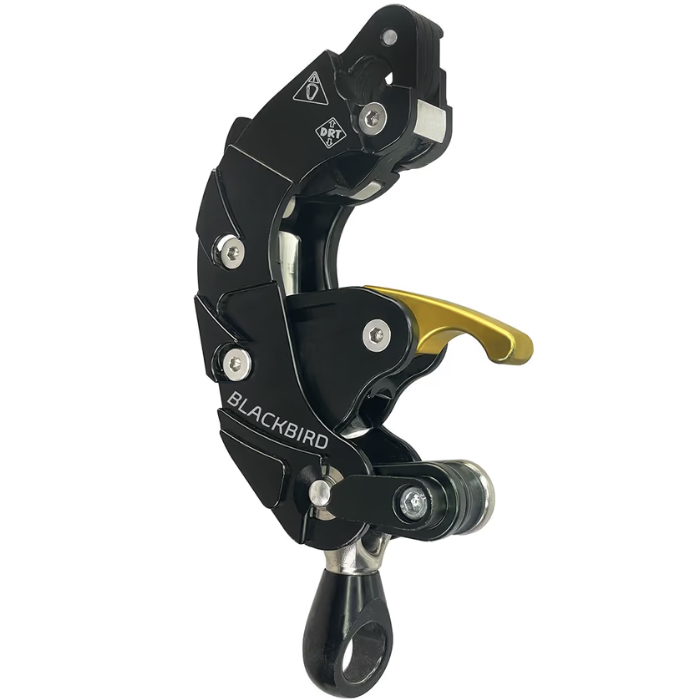
Kei Kinoshita
Here, I’d like to share my impressions after using ART’s Blackbird. As many of you may already know, the Blackbird is a climbing device compatible with both SRS (Single Rope System) and MRS (Moving Rope System). True to ART’s philosophy, it is packed with thoughtful, innovative features down to the finest details.
Design & First Impressions
Let’s start with the look. The black body combined with the golden lever creates a very cool contrast. Upon closer inspection, the gold lever looks like a bird’s beak, making the whole device resemble a blackbird. It’s a fresh, unique design with a playful spirit—very ART-like indeed.
The beak-shaped lever is also easy to operate and feels quite similar to the SpiderJack 3. Another great feature is that you can attach or detach the rope without removing the Blackbird from your harness—an excellent advantage in terms of usability.
Rope Compatibility
Next, let’s talk about rope compatibility. With ropes in the range of 11.5 mm to 11.9 mm in diameter, both double braid and parallel core ropes work smoothly. Even firmer 11 mm parallel core ropes like KM-3 are usable. If you’re a lighter climber, you might be able to use a standard 11 mm parallel core rope without issue. However, at my weight (70 kg), the rope slipped and didn’t hold well.
Though there are some rope diameter limitations, this is still a strong point. While most SRS devices favor parallel core ropes, the Blackbird performs well with both double braid and parallel core ropes in both SRS and MRS setups. That’s the kind of quality you can expect from ART.
Switching Between MRS and SRS
Switching from MRS to SRS is also remarkably smooth. Once you detach the working end, the built-in rope wrench automatically deploys, instantly transforming the device into SRS mode. It’s mechanical yet simple—another hallmark of ART. It feels like watching a Transformer in action. Very cool.
The rope wrench includes a cam that can be rotated to choose between low-friction and high-friction settings. I imagine most climbers will prefer the high-friction mode.
Rope Flow & Performance
The rope flows incredibly smoothly through the device, especially in MRS mode, where it feels as slick and effortless as the SpiderJack. Any ART fan would be satisfied with this level of refinement. Retrieving slack is also smooth and efficient.
Although ART has focused mostly on MRS devices in the past, the Blackbird is their first dedicated SRS device—and its quality is top-tier. Of course, previous MRS devices could be converted for SRS with a rope wrench, but they often became bulky. While the Blackbird weighs over 600g, making it relatively heavy for an SRS device, it remains compact and easy to handle, with no noticeable impact on usability.
Room for Improvement
There are a few areas I’d like to see improved. First, opening and closing the device can be a bit tricky until you get used to it. Once familiar, it’s easy—but it does take some getting used to.
Second, inserting an 11.8 mm parallel core rope can be a little fussy. Again, it becomes easier with practice, but it requires some care and technique. Of course, any device takes time and creativity to master.
Also, be careful not to forget threading the rope through the pulley section for slack retrieval—it’s an easy mistake to make.
Modular Design, True to ART’s Philosophy
— Easy Maintenance and Replaceable Components —
Many of today’s devices from other manufacturers have fewer disassemblable parts, often requiring complete unit or even full-body replacement. The Blackbird, on the other hand, can be taken apart into finer components, making the replacement of worn parts much easier. This modularity is another example of ART’s thoughtful design approach.
Other Concerns
One thing I hope ART improves in future versions is this: when building a 3:1 mechanical advantage system, the tip of the golden beak-like lever can rub against the rope, which doesn’t feel great in use.
Another issue involves the stopper that limits the movement range of the rope wrench. It may break if subjected to a strong impact. In fact, mine did break—sadly, during use by one of six climbing friends who were trying the device. However, even after the stopper broke, the device continued to function just fine. Whether that movement restriction is truly necessary remains unclear, but so far I’ve noticed no performance issues. It’s likely that this range of motion affects how the rope wrench engages.
Conclusion
These are my impressions—and those of several friends—after using the Blackbird in action. As a device compatible with both MRS and SRS, it delivers the quality ART fans expect. It’s a high-performing, uniquely designed piece of gear that I can confidently recommend.
